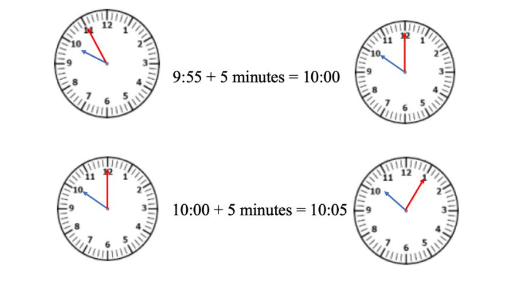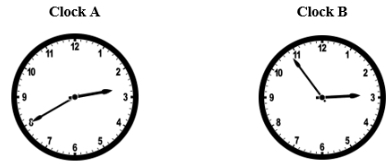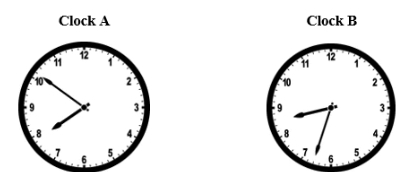Solve one- and two-step real-world problems involving elapsed time.
A bus picks up Kimberly at 6:45 a.m. and arrives at school at 8:15 a.m. How long was her bus ride?
Within this benchmark, the expectation is not to include crossing between a.m. and p.m.
| Name |
Description |
| Post-Hurricane Power Line Inspections | Students will solve real-world problems involving elapsed time to develop a plan for drone inspectors to survey power lines after a hurricane.
This is an open-ended engineering design lesson where students will develop a model to help them solve a problem. There are no “right” answers as the lesson is focused on the process of developing a solution and the skills and reasoning behind the process. Students should be given the freedom to interpret the problem and parameters in unique ways to pursue their own lines of thinking in producing a solution. |
| Patriotism Fair | Students will create a schedule for a Patriotism Fair using their knowledge of four national holidays (Veteran’s Day, Memorial Day, Independence Day, and Founders Month) and elapsed time. An extension activity is included for students to create a banner based on one of the holidays that could be used during an actual Patriotism Fair. |
| Physical Science Unit: Water Beach Vacation Lesson 6 Condensation Experiment | Students set up an experiment and gather data to investigate the condensation of water.
This is a lesson in the Grade 3 Physical Science Unit on Water. This is a themed unit of SaM-1's adventures while on a Beach Vacation. To see all the lessons in the unit please visit https://www.cpalms.org/page818.aspx.
. |
| Physical Science Unit: Water Beach Vacation Lesson 4 Melting Experiment | Students set up an experiment and gather data to investigate the melting of solid water.
This is a lesson in the Grade 3 Physical Science Unit on Water. This is a themed unit ofSaM-1's adventures while on a Beach Vacation. To see all the lessons in the unit please visit https://www.cpalms.org/page818.aspx.
. |
| Physical Science Unit: Water Beach Vacation Lesson 2 Changes to Water: Boiling and Freezing | Students learn water can change state of matter through the addition or removal of heat.
Students will learn the boiling and freezing points of water at standard pressure. Students
will also review how data can be used to create line graphs and these graphs can show
patterns and changes to temperature over time.
This is a lesson in the Grade 3 Physical Science Unit on Water. This is a themed unit of SaM-1's adventures while on a Beach Vacation. To see all the lessons in the unit please visit https://www.cpalms.org/page818.aspx. |
| Are we there yet? Elapsed time to the rescue! | In this lesson students will learn how to use the "mountain strategy" to complete elapsed time word problems. This lesson incorporates a story and hands-on learning and building to make the process fun and engaging. |
| Wow! Where Has the Time Gone? A Lesson on Elapsed Time | The lesson is designed to help students with the concept of elapsed time through the use of T-charts. Students will be able to t solve word problems involving addition and subtraction of time intervals in minutes using situational word problems. |
| "Amazing Race-Elapsed Time" | In this lesson, which focuses specifically on the elapsed time portion of the standard, students work in small groups in a "race" to solve real world problems involving time. |
| How Long is Your Music Lesson? | In this Model Eliciting Activity, MEA, students will be required to rank musical instrument lesson packages based on the price, the number of minutes of practice each week, and the quality of the instructor.
Part of the task involves students figuring out the elapsed time of the lessons based on their start and stop times. They will also need to figure out the total weekly cost of the lessons based on the number of lessons offered per week and the cost of each lesson based on its length.
The twist will require students to determine whether or not to revise their ranking based on new information about the cost of instrument rentals per lesson and the class size of each package.
Model Eliciting Activities, MEAs, are open-ended, interdisciplinary problem-solving activities that are meant to reveal students’ thinking about the concepts embedded in realistic situations. MEAs resemble engineering problems and encourage students to create solutions in the form of mathematical and scientific models. Students work in teams to apply their knowledge of science and mathematics to solve an open-ended problem, while considering constraints and tradeoffs. Students integrate their ELA skills into MEAs as they are asked to clearly document their thought process. MEAs follow a problem-based, student-centered approach to learning, where students are encouraged to grapple with the problem while the teacher acts as a facilitator. To learn more about MEA’s visit: https://www.cpalms.org/cpalms/mea.aspx |
| Cuts In A Rush | In this time rush to get a haircut, students will add elapsed time to find the total time spent at the hair salon and the time of departure from the salon. They must use this information determine which salon is the best for the new family in the neighborhood. Students will submit a letter to the client explaining their procedure for ranking the hair salons.
Model Eliciting Activities, MEAs, are open-ended, interdisciplinary problem-solving activities that are meant to reveal students’ thinking about the concepts embedded in realistic situations. MEAs resemble engineering problems and encourage students to create solutions in the form of mathematical and scientific models. Students work in teams to apply their knowledge of science and mathematics to solve an open-ended problem while considering constraints and tradeoffs. Students integrate their ELA skills into MEAs as they are asked to clearly document their thought processes. MEAs follow a problem-based, student-centered approach to learning, where students are encouraged to grapple with the problem while the teacher acts as a facilitator. To learn more about MEAs visit: https://www.cpalms.org/cpalms/mea.aspx |
| Sweet Donut Shop | In this Model Eliciting Activity, MEA, students will help the Sweet Donut Shop determine what the newest donut will be. Students are given the cost to make each batch along with the selling price and are asked to determine the profit for each batch. Students create a procedure for ranking the donuts and write a letter explaining the procedure and the ranking. In the “twist” students are provided the starting and finishing times for each batch. They must determine the total amount of time, decide if their procedure should change based on the new information, and write a letter explaining whether the procedure changed and the new ranking of the donuts.
Model Eliciting Activities, MEAs, are open-ended, interdisciplinary problem-solving activities that are meant to reveal students’ thinking about the concepts embedded in realistic situations. MEAs resemble engineering problems and encourage students to create solutions in the form of mathematical and scientific models. Students work in teams to apply their knowledge of science and mathematics to solve an open-ended problem, while considering constraints and tradeoffs. Students integrate their ELA skills into MEAs as they are asked to clearly document their thought process. MEAs follow a problem-based, student centered approach to learning, where students are encouraged to grapple with the problem while the teacher acts as a facilitator. To learn more about MEA’s visit: https://www.cpalms.org/cpalms/mea.aspx |
| Time to Play! | This is a 3rd grade MEA that asks the students to determine elapsed time to find the ideal day for another student to stay in and do chores.
Model Eliciting Activities, MEAs, are open-ended, interdisciplinary problem-solving activities that are meant to reveal students’ thinking about the concepts embedded in realistic situations. Click here to learn more about MEAs and how they can transform your classroom. |
| Water Park Fun Day | In this Model Eliciting Activity, MEA, students work as a team to figure out which activities they would like to do at the water park with a given amount of tickets and time. Students will make informed decisions about which activities and food and beverage items on which to spend their allotted tickets.
Model Eliciting Activities, MEAs, are open-ended, interdisciplinary problem-solving activities that are meant to reveal students’ thinking about the concepts embedded in realistic situations. MEAs resemble engineering problems and encourage students to create solutions in the form of mathematical and scientific models. Students work in teams to apply their knowledge of science and mathematics to solve an open-ended problem, while considering constraints and tradeoffs. Students integrate their ELA skills into MEAs as they are asked to clearly document their thought process. MEAs follow a problem-based, student-centered approach to learning, where students are encouraged to grapple with the problem while the teacher acts as a facilitator. To learn more about MEA’s visit: https://www.cpalms.org/cpalms/mea.aspx |
| Group Singing Lessons | Students will decide which performing arts facility their principal should recommend for group chorus singing lessons. They will apply multiplication, division, and time skills for telling time to the nearest minute and time intervals. Students will work collaboratively as a group to analyze this Model Eliciting Activity (MEA), and engage in collaborative discussion that involves higher level critical thinking. They will write letters on which performing arts facility is the best choice.
Model Eliciting Activities, MEAs, are open-ended, interdisciplinary problem-solving activities that are meant to reveal students’ thinking about the concepts embedded in realistic situations. Click here to learn more about MEAs and how they can transform your classroom. |
| Fairies to the Rescue! | During this activity, students will use information on data sets to create a procedure for ranking which parachute design is the best to help the fairies solve their problem.
Model Eliciting Activities, MEAs, are open-ended, interdisciplinary problem-solving activities that are meant to reveal students’ thinking about the concepts embedded in realistic situations. MEAs resemble engineering problems and encourage students to create solutions in the form of mathematical and scientific models. Students work in teams to apply their knowledge of science and mathematics to solve an open-ended problem, while considering constraints and tradeoffs. Students integrate their ELA skills into MEAs as they are asked to clearly document their thought process. MEAs follow a problem-based, student centered approach to learning, where students are encouraged to grapple with the problem while the teacher acts as a facilitator. To learn more about MEA’s visit: https://www.cpalms.org/cpalms/mea.aspx |
| Scheduling a School Day: Creating your own classroom schedule. | In this Model Eliciting Activity, MEA, a group of students has been chosen to help create the classroom time schedule for the school year. The students will have to use the parameters set forth by the teacher and principal, as well as their own expertise about how they learn best, to create a schedule for the school day that includes all subjects and works around time set aside for lunch and special areas. Then the students will have to adapt the schedules they created to accommodate additional considerations by the teacher and principal. This MEA will require students to use their math skills to measure time intervals and their ELA skills to write a letter justifying and explaining the schedule they created.
Model Eliciting Activities, MEAs, are open-ended, interdisciplinary problem-solving activities that are meant to reveal students’ thinking about the concepts embedded in realistic situations. MEAs resemble engineering problems and encourage students to create solutions in the form of mathematical and scientific models. Students work in teams to apply their knowledge of science and mathematics to solve an open-ended problem, while considering constraints and tradeoffs. Students integrate their ELA skills into MEAs as they are asked to clearly document their thought process. MEAs follow a problem-based, student-centered approach to learning, where students are encouraged to grapple with the problem while the teacher acts as a facilitator. To learn more about MEA’s visit: https://www.cpalms.org/cpalms/mea.aspx |
| Transportation Choices | In this Model Eliciting Activity, MEA, students will determine which mode of transportation is best for a traveling sports team. They will have to calculate the total cost for each type of transportation and consider the comfort of travel. In the "twist," students are provided with more information including customer service rating of transportation as well as an additional choice. Students must also calculate the arrival time when given the departure time and the elapsed time to determine if the team will be arriving in time. Additionally, students learn about an option to have a chance to win a drawing based on the cost of the transportation option selected.
Model Eliciting Activities, MEAs, are open-ended, interdisciplinary problem-solving activities that are meant to reveal students’ thinking about the concepts embedded in realistic situations. MEAs resemble engineering problems and encourage students to create solutions in the form of mathematical and scientific models. Students work in teams to apply their knowledge of science and mathematics to solve an open-ended problem, while considering constraints and tradeoffs. Students integrate their ELA skills into MEAs as they are asked to clearly document their thought process. MEAs follow a problem-based, student-centered approach to learning, where students are encouraged to grapple with the problem while the teacher acts as a facilitator. To learn more about MEA’s visit: https://www.cpalms.org/cpalms/mea.aspx |
| Elapsed Time Word Problems | In this lesson, students will discover how an open number line can be a useful tool for determining elapsed time, starting time, or ending time by making connections to solving addition problems with an unknown number as the start, change, or result. Students will complete an elapsed time card activity with partners to practice using open number lines. |
| Your Time Is Up! | Time Out! In this lesson, students will learn about elapsed time. Watching one short video, working with number lines, and working with an online tool will all be ways that the students learn about elapsed time. |
| Hands on the Clock | This lesson gives students an opportunity to apply time knowledge to identify time intervals to the nearest minute. |
| Do You Have a Minute? | In this lesson students use an analog clock to tell time to the nearest minute. Addition word problems involving time increments of minutes are solved by students using a number line. |






